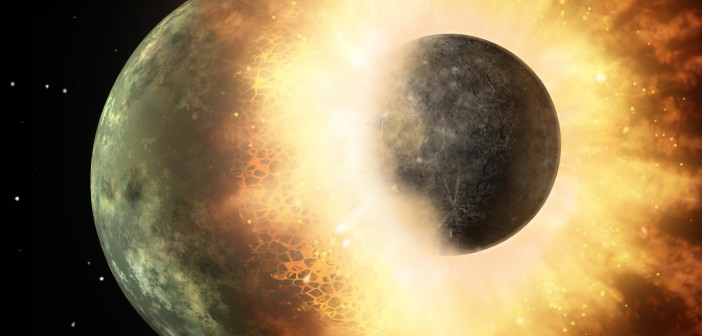In the process of searching for exoplanetary systems, we’ve discovered tens of debris disks close around distant stars that are especially bright in infrared wavelengths. New research suggests that we might be looking at the late stages of terrestrial planet formation in these systems.
Forming Terrestrial Planets
According to the widely-accepted formation model for our solar-system, protoplanets the size of Mars formed within a protoplanetary disk around our Sun. Eventually, the depletion of the gas in the disk led the orbits of these protoplanets to become chaotically unstable. Finally, in the “giant impact stage”, many of the protoplanets collided with each other — ultimately leading to the formation of the terrestrial planets and their moons as we know them today.
If giant impact stages occur in exoplanetary systems, too — leading to the formation of terrestrial exoplanets — how would we detect this process? According to a study led by Hidenori Genda of the Tokyo Institute of Technology, we might be already be witnessing this stage in observations of warm debris disks around other stars. To test this, Genda and collaborators model giant impact stages and determine what we would expect to see from a system undergoing this violent evolution.
Modeling Collisions

Snapshots of a giant impact in one of the authors’ simulations. The collision causes roughly 0.05 Earth masses of protoplanetary material to be ejected from the system. Click for a closer look! [Genda et al. 2015]
The authors find that, over an average giant impact stage, the total amount of mass ejected from colliding protoplanets is typically around 0.4 Earth masses. This mass is ejected in the form of fragments that then spread into the terrestrial planet region around the star. The fragments undergo cascading collisions as they orbit, forming an infrared-emitting debris disk at ~1 AU from the star.
The authors then calculate the infrared flux profile expected from these simulated disks. They show that the warm disks can exist and radiate for up to ~100 Myr before the fragments are smashed into micrometer-sized pieces small enough to be blown out of the solar system by radiation pressure.
The Spitzer Space Telescope has, thus far, observed tens of warm-debris-disk signatures roughly consistent with the authors’ predictions, primarily located at roughly 1 AU around stars with ages of 10–100 Myr. This region is near the habitable zone of these stars, which makes it especially interesting that these systems may currently be undergoing a giant impact stage — perhaps on the way to forming terrestrial planets.
Citation
H. Genda et al 2015 ApJ 810 136. doi:10.1088/0004-637X/810/2/136

2 Comments
Pingback: Discos calientes de grandes impactos « SEDA / LIADA
Pingback: Discos calientes de impactos gigantes | Exoplanetas de la LIADA - Liga Iberoamericana de Astronomía